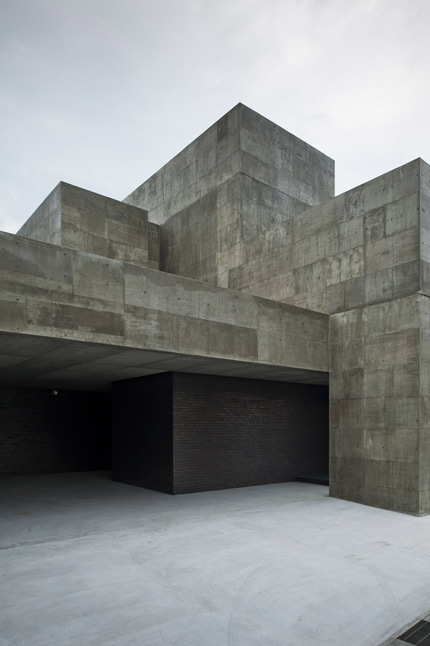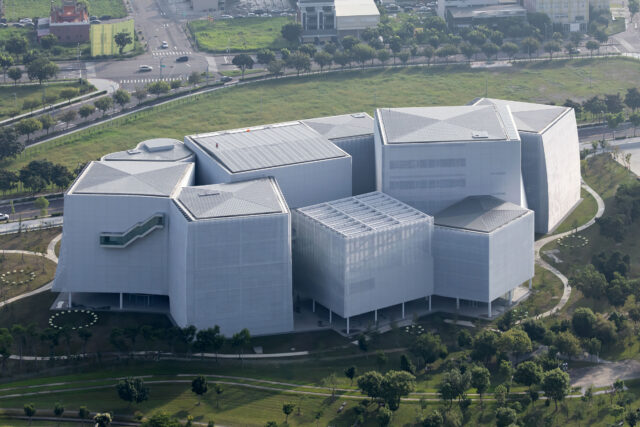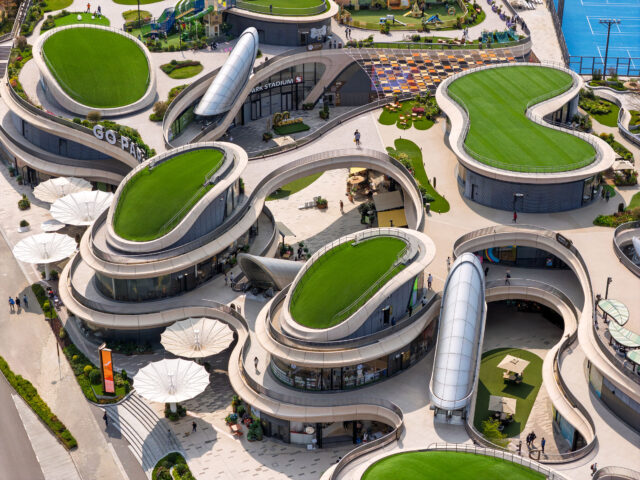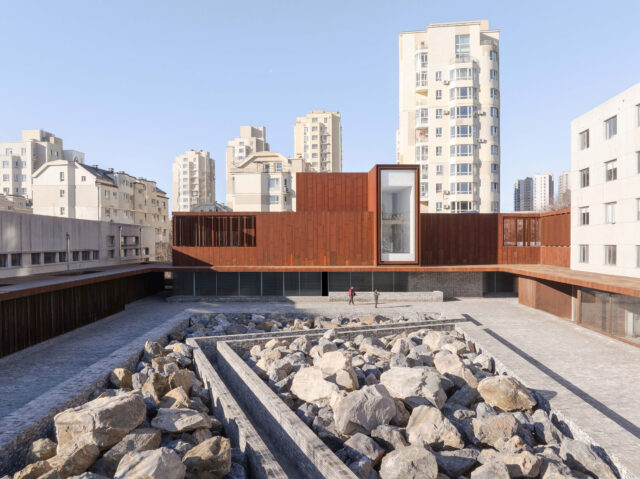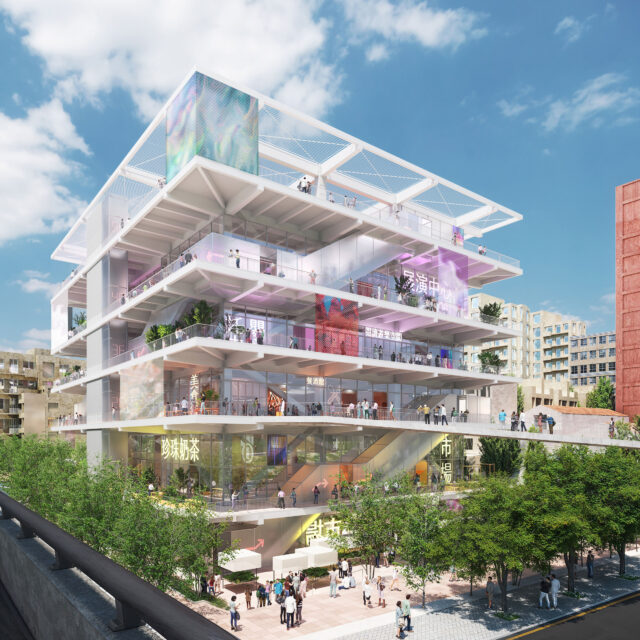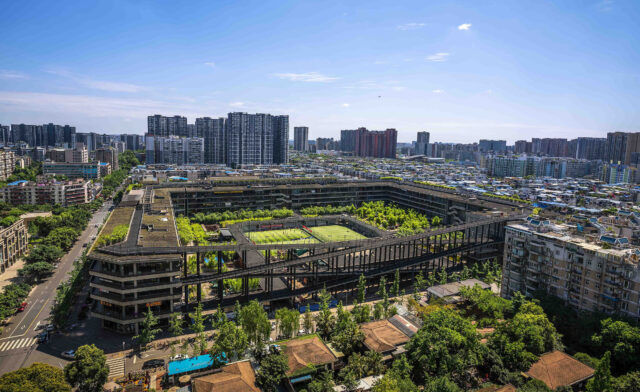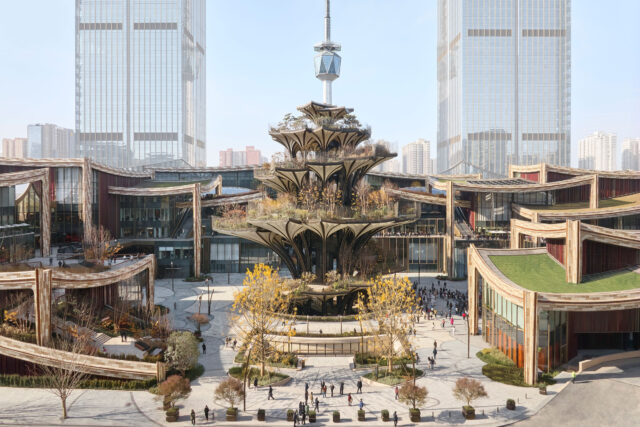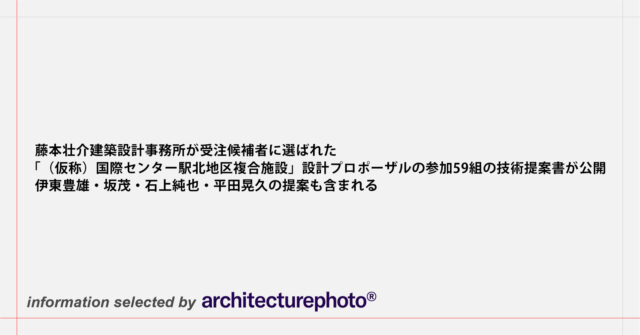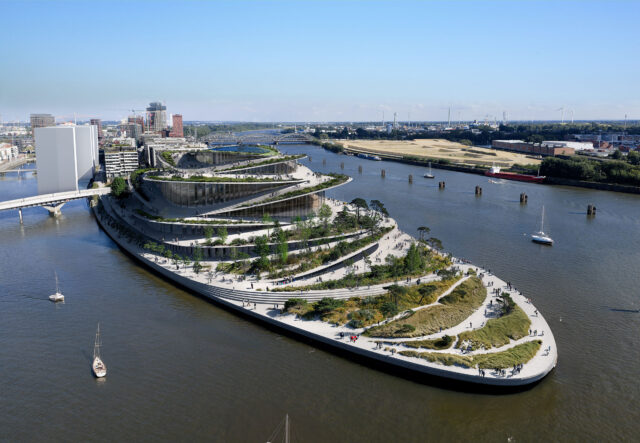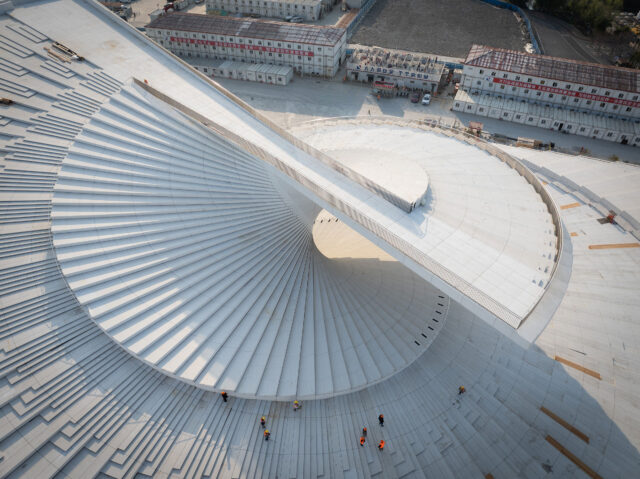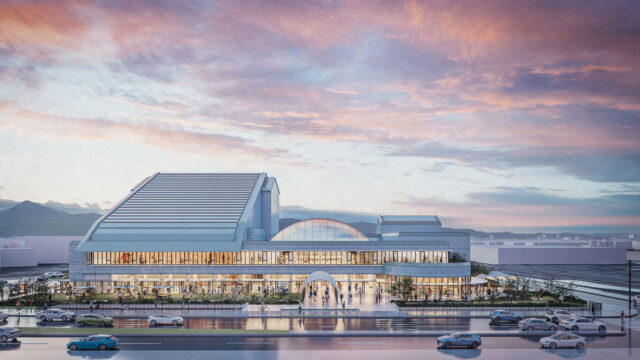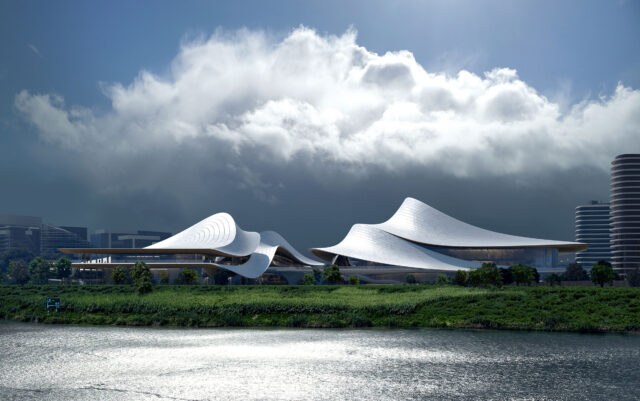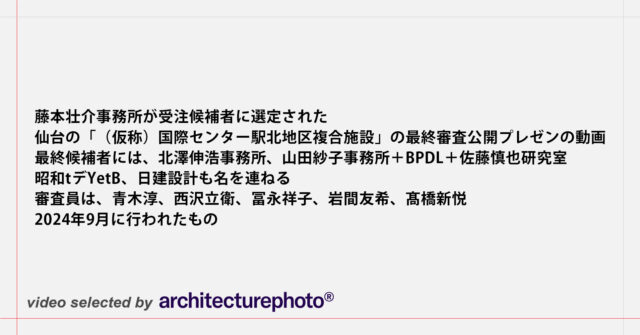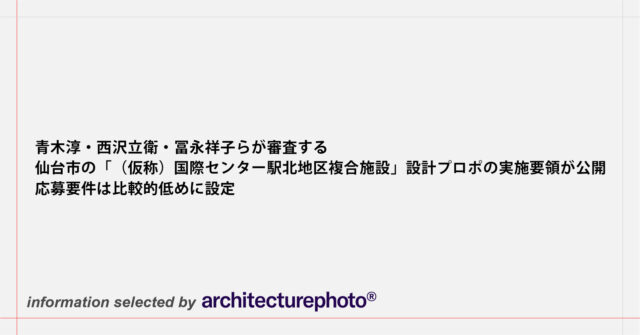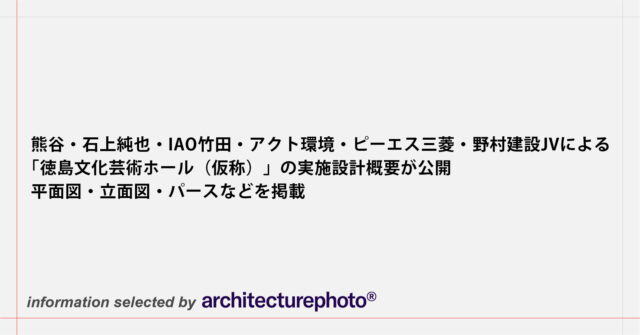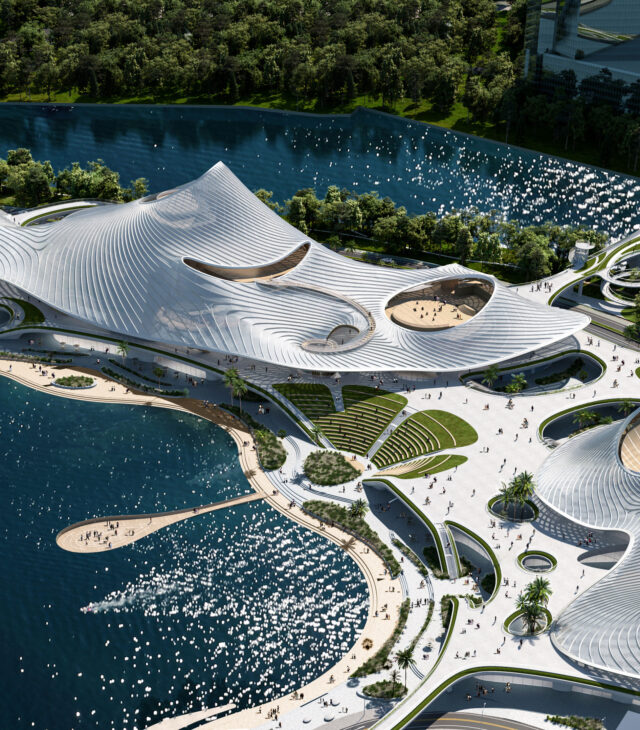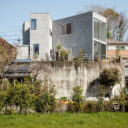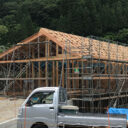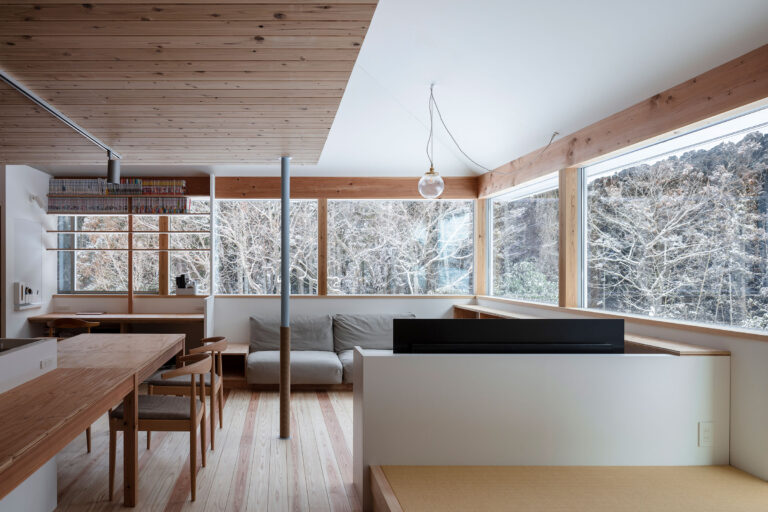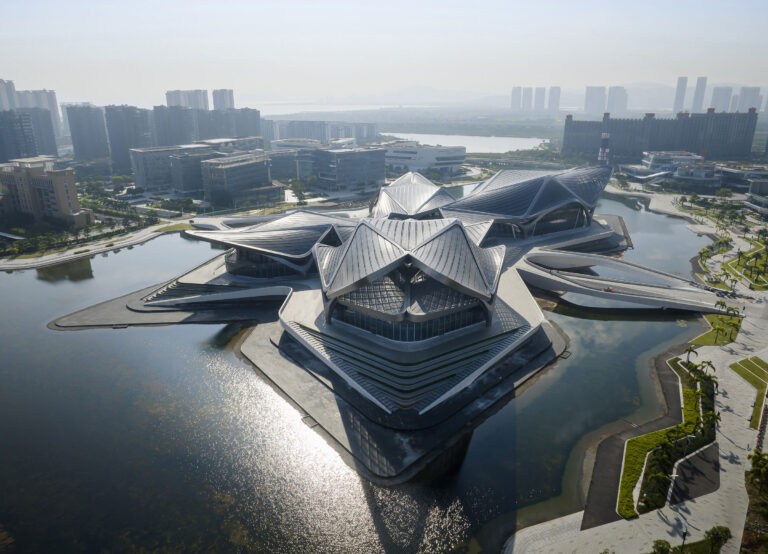
SHARE ザハ・ハディド事務所による、中国・珠海市の「珠海金湾市民芸術センター」。舞台芸術・科学・美術の三施設を内包する建築。現代の創造拠点として、公共広場を中心に諸機能を配置し“渡り鳥の飛行パターン”を参照した形の屋根で覆う構成を考案。特徴的な屋根は施工性や機能性も考慮して設計




ザハ・ハディド・アーキテクツによる、中国・珠海市の「珠海金湾市民芸術センター」です。
舞台芸術・科学・美術の三施設を内包する建築です。建築家は、現代の創造拠点として、公共広場を中心に諸機能を配置し“渡り鳥の飛行パターン”を参照した形の屋根で覆う構成を考案しました。また、特徴的な屋根は施工性や機能性も考慮して設計されました。
こちらはリリーステキストの翻訳です
世界で最もダイナミックな地域のひとつであるこの地域で、現代的な創造性の拠点として設計された珠海金湾市民芸術センターは、珠海の金湾地区に10万人の住民を収容し、新しい市民、文化、学術、商業のインフラを組み込んだ建築面積478万㎡の都市、航空新都市の中心に位置しています。広州-珠海都市間鉄道の延長である珠海空港鉄道は、珠海の市街地と空港を直通で結び、新しい香港-珠海-マカオ橋は、深センと香港の人々が1時間以内に珠海に着くことを可能にします。
珠海金湾市民芸術センターは、3つの文化施設(1,200席の大劇場と500席の多機能ブラックボックス劇場を備えた舞台芸術センター、インタラクティブなサイエンスセンター、美術館)を統合したもので、各施設はそれぞれ異なる特徴が組み込まれ、来場者に異なる体験をもたらしますが、東西170メートル、南北270メートルにわたる首尾一貫した形式的・構造的ロジックによって統一されています。
中央を軸に左右対称に配置された2つの大きな会場と2つの小さな会場は、すべての文化施設の外部ホワイエとして共有される中央広場で結ばれています。この中庭に面したガラス張りの壁によって、来場者は各会場の個性や特徴を知ることができます。グランド・シアターと美術館は明るい色調の素材で仕上げられ、多機能のブラックボックス・シアターと科学センターは暗い色調の素材で構成されています。
中国南部の上空を編隊を組んで飛ぶ渡り鳥のシェブロンパターンを反映し、各会場を覆う格子状のスチール製キャノピーは、繰り返し、対称性、規模の変化によって構成されています。その結果、それぞれの建物の異なる機能要件に対応する関連要素が構成されることになります。この屋根モジュールが自己支持と自己安定を繰り返すことで、プレファブリケーション、プレアセンブリ、モジュール建設の利用が最適化されました。
特徴的な屋根の構造は、センターの4つの翼を包む網目状のシェルの下に、異なる会場を一体化させています。ブリッジとヴォイドを相互に接続することで、センターの中心に多層構造の公共広場が生まれ、内部だけでなく、カフェやレストラン、教育施設のある周辺のプロムナードまで見渡すことができます。デザインは、直感的なナビゲーションを最適化し、すべての公共エリアに自然光を取り入れることで、コネクティビティを高め、地域住民が昼も夜も楽しめる魅力的な市民空間を作り出しています。
グランド・シアターの内部は、センターの外部ルーフ・キャノピーの構成を踏襲し、天井パネルの位置と角度が音響反射板として最適化されている。グランドシアターの吸音面は、国内外での公演に要求される最高の音響基準を満たすように設計されている。
美術館は、屋根のシェブロン幾何学的な形状を適用してメインアトリウムを囲み、美術館に自然光を供給すると同時に、作品を展示するための連続した垂直面を作り出しています。内部のギャラリー、倉庫、管理スペースは、この垂直の区画の背後にあります。建築と展示体験を融合させ、ミュージアムの垂直循環と展示ルートの連続する白い「リボン」が、このミュージアムの特徴となっています。
サイエンス・センターの内装は、センターの屋根の幾何学的な形状を翻訳し、好奇心と学習意欲を刺激するインタラクティブな展示で、科学の革新を紹介しています。サイエンス・センターのレクチャー・ホールは、科学実験や発見の一般公開デモンストレーション・プログラムのために設計されています。
珠海金湾市民芸術センターの基壇は、中興湖の中にある島を定義しています。歩行者用スロープとトンネルが、来場者を湖面を横切って基壇の中央広場に誘い、歩道橋がヴォイドを通って各会場につながっています。モジュラールーフキャノピーに守られたガラス張りのファサードは、透明性を提供し、掃き出し屋根構造の下にある湖畔の遊歩道や広場に地域住民を迎え入れます。センターの西側にある外部円形劇場では、屋外でのパフォーマンスや アクティビティを実施することができます。
コンクリートで造られたセンターは、構造的に独立した5棟の建物からなり、それぞれが自立するスチール製の外部キャノピーを備えています。わずか22本の柱で支えられ、270m×170mに及ぶ自由形状のスチール製ルーフキャノピーは、左右対称のジオメトリーで構成されているため、モジュール式の反復構造をオフサイトで製作し、2種類の柱だけで組み立てることができます。
センターのランドスケープと周囲の湖は、珠海の「スポンジ・シティ」構想に不可欠な要素として設計されており、汚染物質を自然にろ過する水生動植物を利用して、市内の雨水の少なくとも70%を自然浸透、貯留、再利用することを目標としています。ランドスケープ内の灌漑システムには、湿度センサーと土壌水分センサーが設置されており、水の消費量を制御して削減します。
中国南部の海岸沿いの亜熱帯気候に位置するこの建物の外壁は、二重断熱ガラスで熱性能が最適化されており、外部日射遮蔽のための穴あきアルミパネルが組み込まれた格子屋根のキャノピーによって保護されています。パネルに開けられた穴の大きさは様々で、プログラム上の要求、方角、日射取得量に応じて、センター内のスペースに異なる日射を採り入れることができます。夜には、このルーフキャノピーが柔らかな反射光でセンターを照らします。
インテリジェント制御によるエネルギー消費と室内空気質のモニタリング・システムは、センターの室内環境を自動的に調整し、最適な快適性とエネルギー削減を実現します。廃熱回収は、同センターの水リサイクルシステムに接続された節水型機器を使って、同センターの温水需要を満たすために使用されます。中国のグリーンビルディング評価基準の最高レベルを満たすよう設計された同センターの構造部材の選定と調達は、再生鋼材、骨材、その他の構成材料を優先的に使用しました。
以下の写真はクリックで拡大します






















































以下、リリーステキストです。
Designed as a hub of contemporary creativity within one of the world’s most dynamic regions, the Zhuhai Jinwan Civic Art Centre is at the heart of Aviation New City, an urbanisation with a built area of 4.78 million sq. m housing 100,000 residents and incorporating new civic, cultural, academic and commercial infrastructure within Zhuhai’s Jinwan district. The Zhuhai Airport Railway, an extension of the Guangzhou-Zhuhai Intercity Railway, provides direct connections with Zhuhai’s city centre and its airport, while the new Hong Kong-Zhuhai-Macau bridge enables those in Shenzhen and Hong Kong to reach Zhuhai in less than an hour.
Integrating three distinct cultural institutions for the city (a Performing Arts Centre with a 1200-seat Grand Theatre and a 500-retractable-seat multifunctional Black Box theatre; an interactive Science Centre; and an Art Museum) each venue within the Zhuhai Jinwan Civic Arts Centre incorporates unique characteristics that create differing visitor experiences, yet all are united by a coherent formal and structural logic that spans 170 meters wide from east to west and 270 meters long from north to south.
Arranged symmetrically on a central axis, the two larger and two smaller venues are connected by a central plaza that serves as a shared external foyer to all of the cultural institutions. Glazed walls facing this courtyard enable visitors to determine the individuality and character of each venue. The Grand Theatre and Art Museum are finished in a light palate of materials, while the multifunctional Black Box Theatre and Science Centre are composed in darker materials.
Echoing the chevron patterns of migratory birds flying in formation over southern China, the latticed steel canopies sheltering each venue are configured through repetition, symmetry and scale variation; resulting in a composition of related elements that respond to the different functional requirements of each building. This repetition of the self-supporting and self-stabilising roof modules optimised pre-fabrication, pre-assembly and the use of modular construction.
The distinctive roof structure unites the different venues under a network of reticulated shells that envelop the four wings of the centre. Interconnecting bridges and voids create a multi-layered public plaza at the heart of the centre with views to the interiors as well as to the surrounding promenades with their cafes, restaurants and educational facilities. The design optimizes intuitive navigation with natural light in all public areas to enhance connectivity; creating engaging civic spaces for local residents to enjoy throughout the day and evening.
The Grand Theatre’s interior continues the composition of the centre’s external roof canopy with the location and angle of ceiling panels optimised as sound reflectors. The Grand Theatre’s sound absorbing surfaces are designed to meet the highest acoustic standards required for local, national and international performances.
The Art Museum adapts the chevron geometries of the roof to frame the main atrium which provides natural light to the museum while at the same time creating a continuous vertical surface to display artworks. An internal gallery, storage and administrative spaces are located behind this vertical division. Merging architecture with exhibition experience, a continuous white ‘ribbon’ of museum’s vertical circulation and exhibition route is its’ defining feature.
The Science Centre’s interior also translates the geometry of the centre’s roof to showcase scientific innovation with interactive exhibits that inspire curiosity and learning. The Science Centre’s lecture hall is designed for the centre’s programme of public demonstrations of scientific experiments and discovery.
Zhuhai Jinwan Civic Art Centre’s podium defines an island within ZhongXin Lake. Pedestrian ramps and tunnels invite visitors to cross the lake’s surface to the podium’s central public plaza where footbridges connect through voids to each venue. Glazed facades sheltered by the modular roof canopy provide transparency and welcome the local community onto lakeside boardwalks and plazas beneath the sweeping roof structure. An external amphitheatre on the west side of the centre allows for outdoor performances and activities.
Constructed in concrete, the centre consists of five structurally separate buildings, each with its own self-supporting external steel canopy. Supported by only 22 columns and spanning a total of 270m x 170m, these free-formed steel roof canopies are composed of symmetrical geometries to enable their modular, repetitive structures to be fabricated off-site and assembled from only two different column types.
The centre’s landscaping and surrounding lake are designed as integral elements within Zhuhai’s ‘sponge city’ initiative that targets the natural permeation, storage and re-use of at least 70% of the city’s rainwater using aquatic flora and fauna to naturally filter contaminants. Humidity and soil-moisture sensors within the landscaping’s irrigation system control and reduce water consumption.
Located within the subtropical climate of coastal southern China, the double-insulated glazing of the building’s envelope is optimized for thermal performance and protected by the latticed roof canopy which incorporates perforated aluminium panels for external solar shading. The perforations within the panels vary in size to allow differing degrees of sunlight within the centre’s interior spaces in accordance to their programming requirements, orientation and solar gain. At night, this roof canopy bathes the centre in soft reflected light.
Energy consumption and indoor air quality monitoring systems with intelligent control will automatically adjust the centre’s interior environments for optimal comfort and energy reduction. Waste heat recovery will be used to meet the centre’s hot water demand with water-saving appliances connected to the centre’s water recycling system. Designed to meet the highest tiers of China’s Green Building Evaluation Standards, the selection and procurement of the centre’s structural components has prioritized recycled steel, aggregates and other component materials.
■建築概要
Architect: Zaha Hadid Architects (ZHA)
ZHA Design Principal: Zaha Hadid and Patrik Schumacher
ZHA Project Directors: Satoshi Ohashi, Charles Walker
ZHA Project Associate Directors: Lydia Kim, Yang Jingwen
ZHA Project Associates: Mei-Ling Lin, Aurora Santana (SD)
ZHA Project Leads: Mei-Ling Lin, Elena Scripelliti
ZHA Project Core Team: Armando Bussey, Reza Karimi, Julian Lin
ZHA Project CA Team: Qi Cao, Kai-Jui Tsao, Mei-Ling Lin, Juan Liu, Yuling Ma, Feifei Fan
───
ZHA Project Team: Armando Bussey, Marius Cernica, Grace Chung, Nelli Denisova, Xuexin
Duan, Kaloyan Erevinov, Nassim Eshaghi, Kate Hunter, Yang Jingwen, Reza Karimi, Ben Kikkawa,
Lydia Kim, Julian Lin, Mei-Ling Lin, Valeria Mazzilli, Sareh Mirseyed Nazari, Massimo Napoleoni,
Satoshi Ohashi, Yevgeniya Pozigun, Qi Cao, Qiuyu Zhao, Aurora Santana, Hannes Schafelner, Michael
Sims, Patrik Schumacher, Sharan Sundar, Maria Touloupou, Chao Wei, Charles Walker, Kai-Jui Tsao,
Yuling Ma, Feifei Fan
───
ZHA Competition Team: Armando Bussey, Clara Martins, Cristiano Ceccato, Charles Walker,
Ed Gaskin, Filippo Nassetti, Jinqi Huang, Juan Liu, Lydia Kim, Julian Lin, Satoshi Ohashi, Paulo Flores,
Harry Spraiter, Patrick Schumacher, Houzhe Xu, Simon Yu
───
CONSULTANTS:
Local Design Institute: Beijing Institute of Architecture & Design South China Centre
Structural Consultant: Beijing Institute of Architecture & Design South China Centre
Green Building Consultant: Guangdong JORJUN Green Building Technology
BIM Consultant: Beijing BIMTechnologie
Facade Consultant: Zhuhai City Honghai Curtain Wall
Lighting Consultant: Shenzhen Global Lighting Technology
Landscape Consultant: Beijing Institute of Architecture & Design (South China Centre)
Theater Consultant: Shanghai DeYi Engineering Technology
Signage Consultant: W&T Design
Fire Consultant: Beijing Institute of Architecture & Design (South China Centre)
Amplify Consultant: Radio, Film & TV Design and Research Institute
Acoustic Consultant: East China Architectural Design & Research Institute (Acoustic & Theatre
Special Design & Research Division)
Interior Consultant: Shenzhen Z&F Culture Construction
───
CONTRACTORS:
General Contractor: MCC City Investment Holding
Facade Contractor: Shenzhen Sanxin Technology Development
Landscape Contractor: Zhuhai Wuyue Landscape Engineering
Interior Contractor: Shenzhen Weiye Decoration Group

